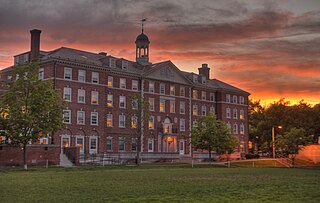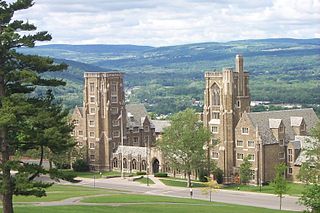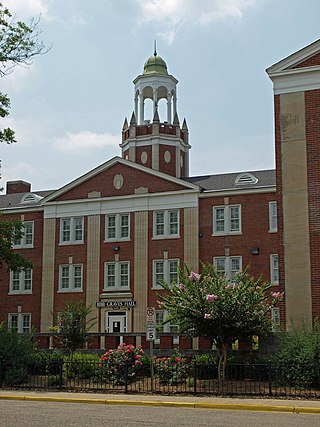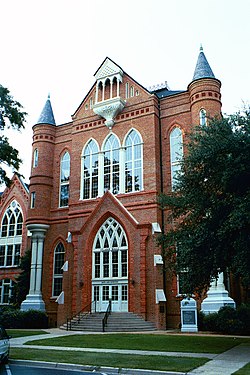
The University of Alabama is a public research university in Tuscaloosa, Alabama. Established in 1820 and opened to students in 1831, the University of Alabama is the oldest and largest of the public universities in Alabama as well as the University of Alabama System. It is classified among "R1: Doctoral Universities – Very high research activity".

The University of Alabama, the state's oldest continuously public university, is a senior comprehensive doctoral-level institution located in Tuscaloosa, Alabama.

Cabot House is one of twelve undergraduate residential Houses at Harvard University. Cabot House derives from the merger in 1970 of Radcliffe College's South and East House, which took the name South House, until the name was changed and the House reincorporated in 1984 to honor Harvard benefactors Thomas Cabot and Virginia Cabot. The house is composed of six buildings surrounding Radcliffe Quadrangle; in order of construction, they are Bertram Hall (1901), Eliot Hall (1906), Whitman Hall (1911), Barnard Hall (1912), Briggs Hall (1923), and Cabot Hall (1937). All six of these structures were originally women-only Radcliffe College dormitories until they were integrated in 1970. Along with Currier House and Pforzheimer House, Cabot is part of the Radcliffe Quad.
A plantation house is the main house of a plantation, often a substantial farmhouse, which often serves as a symbol for the plantation as a whole. Plantation houses in the Southern United States and in other areas are known as quite grand and expensive architectural works today, though most were more utilitarian, working farmhouses.

Landon Cabell Garland (1810–1895), an American, was professor of physics and history and university president three times at different Southern Universities while living in the Southern United States for his entire life. He served as the second president of Randolph–Macon College in Ashland, Virginia, from 1836 to 1846; then professor from 1847 to 1855, and then third president of the University of Alabama in Tuscaloosa, Alabama, from 1855 to 1867; and first chancellor of Vanderbilt University in Nashville, Tennessee, from 1875 to 1893. He was an apologist for slavery in the United States before the Civil War, but afterward became a vociferous spokesperson against slavery.

Josiah Gorgas was one of the few Northern-born Confederate generals and was later president of the University of Alabama.

West Campus is a residential section of Cornell University's Ithaca, New York campus. As defined by the 2008 Master Plan, it is bounded roughly by Fall Creek gorge to the north, West Avenue and Libe Slope to the east, Cascadilla gorge and the Ithaca City Cemetery to the south, and University Avenue and Lake Street to the west. It now primarily houses transfer students, second year students, and upperclassmen.

Talladega College is a private, historically black college in Talladega, Alabama. It is Alabama's oldest private historically black college and offers 17 degree programs. It is accredited by the Southern Association of Colleges and Schools.

The Old University of Alabama Observatory, now known as Frederick R. Maxwell Hall, was an astronomical observatory owned and operated by the University of Alabama in Tuscaloosa, Alabama. Although no longer used as an observatory, the building has been restored and preserved. It currently houses the university's Collaborative Arts Research Initiative (CARI), an interdisciplinary, arts-focused research engine driven by the interests of faculty from across the university. By facilitating collaborations across disciplines, CARI maximizes the impact of faculty arts research, while enriching the university, local, and regional communities. Significant for its architectural and historical importance, it was added to the National Register of Historic Places on January 14, 1972.

Waldwic, also known as the William M. Spencer, III, House, is a historic Carpenter Gothic plantation house and historic district located on the west side of Alabama Highway 69, south of Gallion, Alabama. Built as the main residence and headquarters of a forced-labor farm worked by enslaved people, Waldwic is included in the Plantation Houses of the Alabama Canebrake and Their Associated Outbuildings Multiple Property Submission. The main house and plantation outbuildings were added to the National Register of Historic Places on July 22, 1994.

Faunsdale Plantation is a historic slave plantation near the town of Faunsdale, Alabama, United States. This plantation is in the Black Belt, a section of the state developed for cotton plantations. Until the U.S. Civil War, planters held as many as 186 enslaved African Americans as laborers to raise cotton as a commodity crop.

Rosemount is a historic plantation house near Forkland, Alabama. The Greek Revival style house was built in stages between 1832 and the 1850s by the Glover family. The house has been called the "Grand Mansion of Alabama." The property was added to the National Register of Historic Places on May 27, 1971. The Glover family enslaved over 300 people from 1830 until 1860.

Fairhope Plantation is a historic Carpenter Gothic plantation house and historic district, located one mile east of Uniontown, Alabama, US. The 2+1⁄2-story wood-framed main house was built in the Gothic Revival style in the late 1850s. The plantation historic district includes six other contributing buildings, in addition to the main house. It was added to the Alabama Register of Landmarks and Heritage on December 19, 1991, and subsequently to the National Register of Historic Places on May 29, 1992, due to its architectural and historical significance.

The Quad is an approximately 22-acre (8.9 ha) quadrangle on the campus of the University of Alabama located in Tuscaloosa, Alabama. Home to most of the university's original buildings, this portion of the campus remains the geographic and historic center of the modern campus. Originally designed by noted English-born architect William Nichols, construction of the university campus began in 1828, following the move of the Alabama state capital from Cahaba to Tuscaloosa in 1826. The overall design for this early version of the campus was patterned after Thomas Jefferson's plan for the University of Virginia, with its Lawn and Rotunda. Following the destruction of the campus during the American Civil War, a new Quad emerged in the late 19th and early 20th centuries. Different in form and function from the original design of the early 19th century, the modern Quad continues to fill its role as the heart of the campus. Although surrounded by academic and administrative buildings, only five structures are built directly on the Quad: the Little Round House, Tuomey Hall, Oliver-Barnard Hall, Amelia Gayle Gorgas Library, and Denny Chimes. The remainder of the space is occupied by a grove of trees on the west side and a great lawn on the east. A feature on the northwestern side, known as The Mound, is the site of the old Franklin Hall. A popular gathering place, the Quad is home to pep rallies, a bonfire during homecoming, and numerous day-to-day student activities.

The President's Mansion is a historic Greek Revival style mansion on the campus of the University of Alabama in Tuscaloosa, Alabama. It has served as the official residence of university presidents ever since its completion in 1841. The structure narrowly avoided destruction during the American Civil War, making it one of the oldest surviving buildings on campus today. The mansion was added to the National Register of Historic Places on January 14, 1972, due to its architectural and historical significance.

The Alabama State University Historic District is a 26-acre (11 ha) historic district at the heart of the Alabama State University campus in Montgomery, Alabama. It contains eighteen contributing buildings, many of them in the Colonial Revival style, and one site. The district was placed on the Alabama Register of Landmarks and Heritage on August 25, 1994, and the National Register of Historic Places on October 8, 1998.
The president of The University of Alabama is the university's chief administrator, appointed by the board of trustees. The first to occupy the President's Mansion, on University Boulevard opposite the Quad, was Basil Manly, Sr., the university's second president.

Eugene Allen Smith was an American geologist.

William J. Vaughn (1834-1912) was an American university professor, school principal, librarian and book collector. He was one of the earliest Professors at the University of Alabama in Tuscaloosa, Alabama, and at Vanderbilt University in Nashville, Tennessee.






















